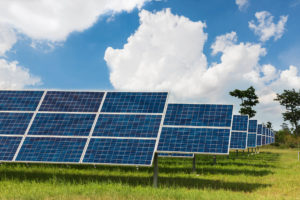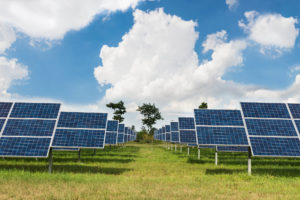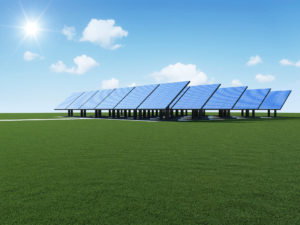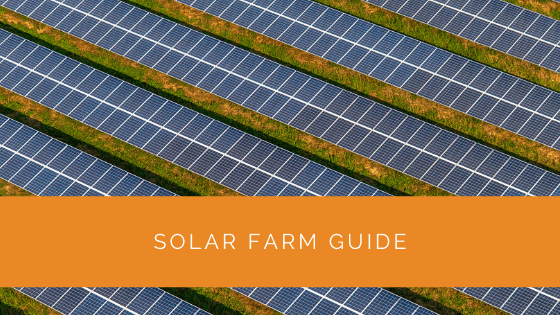With the rising popularity of solar energy consumption, a new crop has sprouted on many modern farm fields worldwide – solar panels. These areas consisting of solar panels having various shapes and sizes are called solar farms.
So, even if you’re a traditional farmer in America, the thought of setting up a solar farm might have crossed your mind. As numerous solar farms have been popping up in the US and lighting up homes efficiently, this promises a massive step towards utilizing green energy.
If you’re interested in setting up a solar farm or just want to know more about it, this post will walk you through all the necessary details.
Contents
- 1 Key Takeaways
- 2 What Are Solar Farms?
- 3 What Are the Different Types of Solar Farms?
- 4 What Does a Solar Farm Look Like?
- 5 Building a Solar Farm: Things to Keep in Mind
- 6 What Are the Benefits of Having a Solar Farm?
- 7 Case Study: Establishing a Community Solar Farm for Sustainable Energy
- 8 Expert Insights From Our Solar Panel Installers About Solar Farms
- 9 Experience Solar Excellence with Us!
- 10 Endnotes
Key Takeaways
- Solar farms, also known as photovoltaic power stations, consist of solar panels that absorb sunlight and convert it into electricity, which is then transferred to a power grid for distribution.
- There are two main types of solar farms: utility-scale solar farms, which are large and owned by utility companies, and community solar farms, which serve local communities and residences.
- Solar farms offer benefits such as significant cost savings on electricity bills, environmentally friendly energy production, and the ability to generate income by selling excess electricity to utility companies or local communities.
What Are Solar Farms?
A solar farm is also known as a photovoltaic power station. This farm consists of many solar panels used to absorb sunlight and convert it into electricity. The electricity is then transferred to a power grid and distributed to communities for consumption.
These farms are also called solar power stations, as they work as individual power plants for producing and distributing energy across localities.
Unlike the rooftop solar panels you might have come across, all the solar panels in a solar farm are mounted on the ground. Therefore, instead of being connected to a residence or a commercial property, these forms can be considered decentralized. Hence, the panels generate electricity and supply it to an electric grid instead of a local end-user.
Some organizations or businesses establish their solar farms to power their data centers or other operations.
What Are the Different Types of Solar Farms?
Solar farms have become extremely popular and can be easily implemented to generate electricity. They have been categorized into two divisions based on their use and distribution. Let’s check them out here:
Utility-Scale Solar Farms
These solar farms are power plants and are usually owned by a local utility company. These areas are massive and may consist of thousands of solar panels mounted on the ground to absorb sunlight, produce an electric current, and send that power to a high-voltage power line.
Electricity in these power lines is then sent to an electricity grid. There, it is prepared for distribution. These solar farms generate a lot of electricity which may go up to 1 GW.
Due to the massive size of these projects, many utility companies have acquired acres of land to install solar panels on such a large scale. These facilities work on a power purchase agreement. Here, the company signs a contract to purchase a particular amount of generated electricity from the utility for its generators.
In some cases, the entire farm may be owned and operated by the utility to distribute the electricity to commercial or residential properties. However, this property needs to be connected to the utility grid.

Community Solar Farms
These small solar farms produce enough electricity to serve a local community consisting of offices and residences. Unlike utility-scale solar farms, these farms are much smaller and consist of fewer solar panels installed. They typically generate 5 W of power.
Many home and office owners have realized that they don’t necessarily need solar panels on the rooftop. They have started sharing electricity from a community solar farm. On the other hand, you can either buy a portion of this solar farm or lease energy from the farm.
People who have opted for such a solar energy distribution program will have their monthly utility payments replaced with solar energy bills. Depending on the amount of consumption and the size of the property, users can enjoy a significant reduction in electricity expenses.
The retail company overseeing the community solar project will adjust your bill as per your property’s energy load and the power generated by the solar farm.
Furthermore, community solar farms are also considered Distributed Energy Resources (DER). As these farms serve homes or offices nearby, they don’t suffer much power loss even if the electricity grid shuts down temporarily.
Microgrids
You can consider microgrids a smaller version of a larger electric grid. It can disconnect from the grid and work independently. Therefore, if harsh weather conditions affect the area, a microgrid can disconnect from the main grid and continue producing electricity to homes or commercial spaces.
Older microgrids worked on diesel generators, but modern designs utilize a combination of solar energy and a battery backup. So, if a severe power outage occurs, the microgrid can continue supplying electricity and put things back together over a reliable source of energy soon as the power is restored.
Apart from batteries and generators, microgrids are primarily powered by energy sources like solar panels. They are energy-efficient and incredibly resilient. Thus, they offer a reliable energy source to facilities with high electricity requirements, such as hospitals.
What Does a Solar Farm Look Like?
A solar form consists of hundreds of thousands of solar panels mounted on the ground. The length of the farm ranges between 10 and 100 acres of land. If you walk by a solar farm, you will see solar panels positioned on racking systems and arranged in rows.
The panels are mounted in such a way that most of the land is utilized optimally. However, the land used for the solar farm has to be completely flat and cleared of all vegetation. Wetlands are usually avoided. Also, the form needs to be closer to a transmission substation, power grid, and the communities.
Sometimes, an area of a working farm can be cleared out to set up solar panels, as these are safe and pose no threats to adjacent fields, crops, or livestock.

Building a Solar Farm: Things to Keep in Mind
As many companies and individuals have realized the true potential of solar energy, they are becoming interested in setting up one by themselves.
If you are interested in harnessing the power of solar energy and starting a solar farm, there are few things you need to keep in mind. These are explained in the following sections.
Land Requirements
The first step in building a solar farm is determining the amount of land you need. Utility-scale solar farms generate approximately 1 MW e of power required around a hundred acres of land. On the other hand, a small-scale solar farm may be established within 15 acres of land.
You can either purchase land for the farm or lease it. However, make sure to rent it for 50 years at least to keep on generating electricity for years.
Additionally, always try to choose lands that are not good for agricultural cultivation and dry. As these lands don’t generate much income, you might get them at an affordable deal.
Electrical Connection
The next important factor you need to consider is the electrical connection required for the farm to work. Your chosen land must be located near the power lines and the transmission substation.
The location will allow you to understand the feasibility of connecting your solar panels to a centralized power source or the power grid.
Number of Solar Panels
The number of solar panels you have on your farm will decide the amount of electricity it will generate. To find the exact number of panels, you need to find out the energy required to power up the nearby community. You also have to figure out the production ratio for solar panels in your area. This will let you know the amount of energy a particular solar panel wattage can produce.
You can also contact your local power supply company or an expert to know more about this.
Setting Up the Structure
After gathering all the initial know-how, it’s time to start setting up the solar panels for your farm. If you don’t know how to do it, you can contact engineers or experts to help you. You can also contact companies to mount the solar panels and establish the entire solar farm for you.
It is best to work with a company that constructs everything for you and also provides maintenance and renovation services for your farm. This will allow you to work with them for a long time, saving costs in the long run.
Whatever you do, ensure that the land is easy to maintain and use.
Start Marketing Your Farm
Besides using the solar farm to generate electricity for you and your neighbors, marketing your farm will be a better financial decision. You can start by reaching out to local utility companies to sell your generated electricity.
Some companies may even contact you while establishing the farm. Talk to them in detail about what you can provide and how the power supply, electric bills, and associated payments will work. Moreover, it would be best to also talk about the service costs of using your solar farm to generate power.
Make sure to get in touch with multiple companies before settling for one, as it will enable you to get the best price for your services.

What Are the Benefits of Having a Solar Farm?
Whether you are setting up your farm or using someone else’s services, here are some excellent benefits of solar farming:
- The return on investment is excellent, with significant savings in your electricity bills and a steady source of power.
- Animal grazing is possible between the rows of solar panels, making the land multi-purpose and more cost-efficient.
- They offer reliable and clean energy, as the sun is a perennial energy source.
- No harmful emissions for pollution are caused due to solar farms, making them very eco-friendly.
- These farms don’t have many moving parts, and the inverters are covered in sound-proof boxes. So, constructing and operating these farms can be done quietly.
- These farms can be established in any part of the world, even if the sun shines only for a few hours.
- They need very little maintenance, and the semi-yearly check-up will suffice. As these farms can work efficiently for more than ten years, you will save a lot on maintenance costs.
Case Study: Establishing a Community Solar Farm for Sustainable Energy
Background
At Solar Panels Network USA, we pride ourselves on facilitating sustainable energy solutions tailored to the needs of diverse communities. Recently, we undertook a project to establish a community solar farm in a suburban area to provide clean and renewable energy to local residents and businesses.
Project Overview
The community solar farm aimed to generate sufficient electricity to power approximately 500 homes and several small businesses in the area. The goal was to reduce the overall carbon footprint, lower energy costs for participants, and promote the adoption of renewable energy sources within the community.
Implementation
Land Acquisition and Preparation: We identified a 20-acre plot of land on the outskirts of the suburb that was ideal for the solar farm. The land was flat, unused for agricultural purposes, and in close proximity to the local power grid and transmission substation.
Design and Setup: After securing the land, our team designed a layout to maximize solar exposure and efficiency. We installed 10,000 high-efficiency photovoltaic panels arranged in rows with optimal spacing to ensure minimal shading and maximum energy capture.
Infrastructure and Connectivity: We integrated advanced inverters and transformers to convert the generated DC power to AC power suitable for the grid. A robust monitoring system was set up to track the performance of each panel and the overall energy production in real-time.
Community Engagement: We launched an outreach program to educate local residents and businesses about the benefits of participating in the community solar farm. We provided options for purchasing a share of the solar farm or subscribing to receive a portion of the generated electricity, with the promise of reduced energy bills and environmental benefits.
Results
Energy Production: The community solar farm successfully generated an average of 5 MW of electricity, meeting the energy needs of the participating homes and businesses. The project significantly reduced reliance on fossil fuels and lowered the community’s overall carbon emissions.
Cost Savings: Participants experienced a reduction in their electricity bills by up to 20%, thanks to the stable and lower-cost solar energy. The savings incentivized more residents and businesses to join the program, expanding the farm’s impact.
Sustainability Impact: The solar farm’s annual energy production offset approximately 3,500 metric tons of CO2 emissions, contributing positively to the environment and setting a precedent for sustainable community initiatives.
Community Benefits: The project fostered a sense of community involvement and responsibility towards environmental conservation. It also provided an educational platform for local schools and organizations to learn about renewable energy and sustainability practices.
Summary
The community solar farm project by Solar Panels Network USA stands as a testament to the potential of renewable energy solutions in fostering sustainable communities. Through careful planning, effective implementation, and active community engagement, we successfully established a solar farm that not only provided economic benefits but also contributed significantly to environmental conservation. This project underscores our commitment to promoting clean energy and empowering communities to adopt sustainable practices.
Expert Insights From Our Solar Panel Installers About Solar Farms
Setting up a solar farm involves meticulous planning and a thorough understanding of the land and electrical requirements. Ensuring proper land assessment and proximity to power grids can significantly enhance the efficiency and feasibility of the project.
Senior Solar Engineer
Utility-scale solar farms offer a tremendous opportunity for large-scale energy production, but they also require substantial investment and maintenance. Partnering with experienced installers can streamline the process and ensure optimal performance.
Lead Solar Installer
Community solar farms are an excellent way for local communities to harness renewable energy. They provide a cost-effective solution for residential and commercial properties to benefit from solar energy without the need for individual installations.
Solar Energy Consultant
Experience Solar Excellence with Us!
Trust in Solar Panels Network USA, where our seasoned experts deliver top-quality solar solutions for homes and businesses nationwide. With a legacy of countless successful installations and a commitment to sustainable energy, we’re your reliable partner in the solar journey. Ready for a brighter, eco-friendly future? Call us now at (855) 427-0058 and harness the power of the sun!
Endnotes
Over the years, solar farms have become excellent sources of generating uninterrupted electricity for communities. Not only can these farms cut down your power costs, but you can also generate profitable income by installing a farm yourself.
However, solar farms require quite a lot of land for their establishment, which may be a little expensive. But, their power efficiency and reliability outweigh the high installation expenses.
So, if you’re interested in reducing your electric bills or investing in a solar farm, this article will help you kickstart your journey!
About the Author
Solar Panels Network USA stands at the forefront of solar energy solutions, driven by a team of seasoned solar engineers and energy consultants. With over decades of experience in delivering high-quality solar installations and maintenance, we are committed to promoting sustainable energy through customer-centric, tailored solutions. Our articles reflect this commitment, crafted collaboratively by experts to provide accurate, up-to-date insights into solar technology, ensuring our readers are well-informed and empowered in their solar energy decisions.

